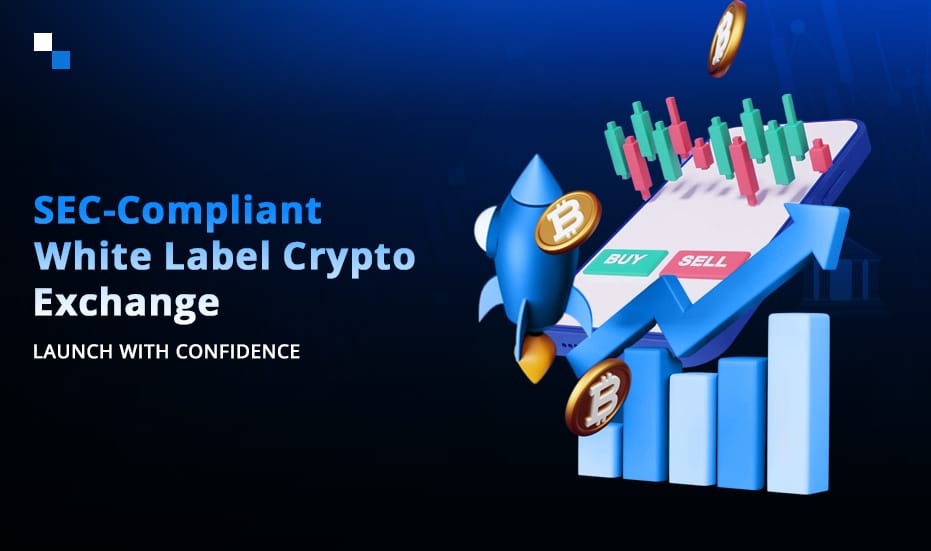
A Complete Guide on Binance Smart Chain Based DeFi Dapp Development
September 10, 2021
DeFi Staking Platform Development: A Fast Growing Revenue Stream for Institutions & Investors
September 15, 2021Designing and running products for the booming, open financial industry is not an easy task for any cryptocurrency software development firm. Nonetheless, companies and services in this field are flourishing and white label exchange software is in demand.
In general, a white label product is a ready-to-use platform that can be further customized based on the business model and features of the final product. A white label crypto exchange platform is an end-to-end market-ready solution that can be easily deployed at both the front-end and the back-end.
It is a protocol that allows cryptocurrency trading companies to efficiently develop a high-performing exchange platform. Furthermore, that would enable the users in buying, selling, converting, trading, staking, and holding cryptocurrencies.
However, what is the most important feature of any white label crypto exchange platform? That is security! Any crypto exchange earns its revenue from transaction fees, management fees, etc. However, to make the earnings the exchange platform needs a sizable user base that can only be achieved if the traders feel secure while trading on the exchange. Hence, security is the most important feature of any white label crypto exchange platform. It not only helps achieve a more user base but also paves the way to long-term success for the venture.
Let’s discuss some of the key security features that make a white label crypto exchange platform a highly secure solution.
1. Two-Factor Authentication
Two-factor authentication is a well-known security feature that may be found in a wide range of digital platforms. In all cutting-edge crypto exchanges, this function serves as a secondary security layer. This feature is used by all of the popular social networking apps and websites for high-end security. Gmail, Twitter, Facebook, and other social media sites are examples. It has numerous security features in crypto exchanges. Users can only complete the crypto transaction after entering two verification passwords.
For verification, you can use a pin code, mobile number, OTP, Gmail verification code, or fingerprint. As a result, this function adds to the security of consumers’ cryptocurrency exchange accounts. By utilizing this feature in your white label crypto exchange, you can protect your users from cyber-attacks and third-party meddling.
2. Registry Lock
Registry Lock is mostly used to provide an extra degree of security to crypto trading platforms. This function aids in the domain name’s locking. It also allows the domain name owner to lock the information on the domain. The name of various operations is blocked by a registry lock; content alteration, DNS modification, domain transfer, and domain name deletion are only a few examples. This functionality safeguards your software or exchange by preventing unauthorized changes or deletion of critical domain parts. It also prevents anyone from changing the registration information.
If the registry lock is integrated into your white label exchange software, you won’t be able to change the domain name. If you wish to change or modify something, it will ask for a three-way passcode. This type of check is completed entirely by three people – the domain registrant (Owner), the registrar (your service provider), and the registry itself. So you may get high-end security for your white label crypto exchange software by employing a registry lock.
Launch Your Own White Label Crypto Exchange in 7 Days
Schedule Free Demo3. Biometric Authentication
Many platforms employ biometric authentication as the most prevalent feature. This feature is now available as a security feature on many devices. People actually prefer biometric authentication to enter a password or pin code. Biometric authentication is widely utilized across a variety of platforms, including mobile apps, bank payments, and more. For verification, it is entirely based on single biological traits.
You can store a fingerprint or a palm print in the white label crypto exchange software for a secure transaction. As a result, anonymous hackers will be unable to steal cryptocurrency from the wallet. Your white-label software will be more secure as a result of this. It will also prevent unnecessary logins.
4. Data Encryption
A different method is used to encrypt all data in the blockchain network. As a result, decrypting data from a blockchain will be challenging for attackers. The data is saved in three different ways during the transaction. The private key, public key, and digital signature are few examples of the same. During a cryptocurrency transaction, these parameters are used. Furthermore, no name or other identifying information is used. They’re also fully recorded in the distributive ledger. The transactions are entirely peer-to-peer, and advanced blockchain technologies are used.
5. Preventing Cross-Site Request Forgery
Cross-site Request Forgery (CSRF) is a type of deception. It’s done by anonymous attackers delivering harmful requests or unknown links to a user’s web browser. Users may react to harmful requests without realizing the consequences. As a result, the attackers target the user’s web browser and this data breach leads to theft of important information. Users may lose both their passwords and their money. You can prevent these attacks and forgeries as a crypto exchange owner by incorporating CSRF prevention in your white label exchange software.
6. DNSSE
DNSSE is an acronym for Domain Name System Security Extension. It is mostly used to verify all DNS (Domain Name System) inquiries. To validate data, DNSSE uses a combination of public keys and digital signatures. Unauthorized Domain Name System Entries can be restricted using this functionality. It protects you from accessing banned websites and engaging in dangerous behavior. Cache poisoning and pharming are two examples. This security mechanism is currently used by less than 10% of crypto trading sites. However, DNSSE does not protect your white label crypto exchange software against DDoS attacks, which is a significant disadvantage.
7. Hardware Security Modules (HSM)
The HSM stands for Hardware Security Module. It is a physical device that can be totally connected to the network, either as a plug-in or as an external device. HSM is a reliable network that carries out the challenging task of cryptography. It is made up of cryptoprocessor chips that help protect against anonymous attacks and bus probing.
Because it is constructed on specialized hardware, Hardware Security Modules may be trusted. It runs on a secure operating system. Internal norms and regulations regulate HSM fully. It’s best for providing high-end protection for cryptographic data. So you’ve integrated HSM into your white label exchange platform.
These are the most important and effective security elements to include in your white label software. Cold wallets, multi-signature vaults, online security protocols, and Anti-DDoS modules are also available.
If you want to launch a crypto exchange, you should choose the best white label crypto exchange software available with these features. After all, crypto trading is famous for its high-security parameters and robust blockchain coding, and any compromise on threat detection and data breach can lead to a deficit in the user base and trust.
At Antier Solutions, we offer a world-class white label exchange solution fortified with market-leading features, such as high transaction processing speed (up to 100,000 transactions per second), multi-sig wallet, powerful trading engine, multi-layer security, multi-currency support, and more.
Schedule a free demo of our white label crypto exchange or connect with our subject matter experts to share your needs.



